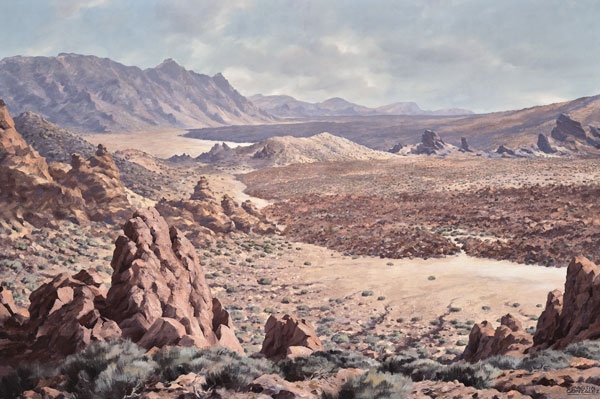Temporary exhibition
Malpaís
Agustín Espinosa, author of the most surprising guide to the island of the Fire Mountains, was born 125 years ago: Lancelot 28º 7º. At that time, the representation of the igneous nature of the archipelago in art was almost reduced to the few examples in which some of its historical eruptions were documented, or to the inventory of the volcanic geography due to scientists and tourists, attracted by the record of the peculiar. Canarian painters relegated the magnificent lava masses to a distant scene in the landscapes of the valleys and island villages, where the abrupt reality of the inhospitable badlands and the struggle with a difficult, limited and contradictory land seemed to be diluted as a background for a more pleasant picture. But, with time, the iconography of the volcano -the great conical mountain, the coast reached by the lava flows or the clean plane of black ashes-, acquires its own entity, either as aesthetic experimentation suggested by the capricious and sublime forms born from the magmatic fluids and erosion, or sometimes as a lyrical inquiry of man in terms of a landscape solidified in his retina and crusted on the soniquete of an identity always on tenterhooks.
It is also fifteen years since Teide was declared a World Heritage Site, the most visited of Spain’s sixteen national parks, four of which are located in the Canary Islands. The recognition of the natural and cultural value linked to the eruptive activity in the islands implies the duty to develop tools for its conservation, but at the same time it may accentuate and accelerate the threat of tourist overexploitation and speculation to which is usually subjected that which is indicated as unique.
From another perspective, if the safeguarding of our natural monuments is complex, no less complex is the challenge of rebuilding a large part of the island of La Palma, which was engulfed under the badlands and ashes a year ago, recalling stories known centuries ago. The tremor of uncertainty once again marks our isolated rhythm. Behind the volcano, whose shadow is long, there is the malpaís, a land without earth, where it is improbable to sprout. All burned, covered with slag and ash, the barren field of lava, still warm in its rumor, will not take long, however, to fertilize ecosystems and plough new gazes that join those gathered here.
Eliseo G. Izquierdo

